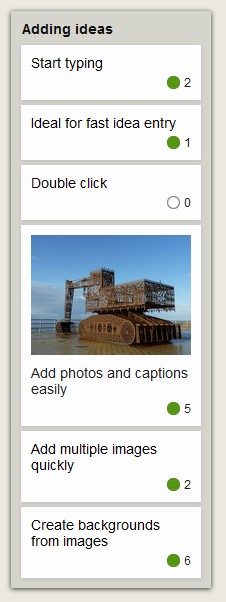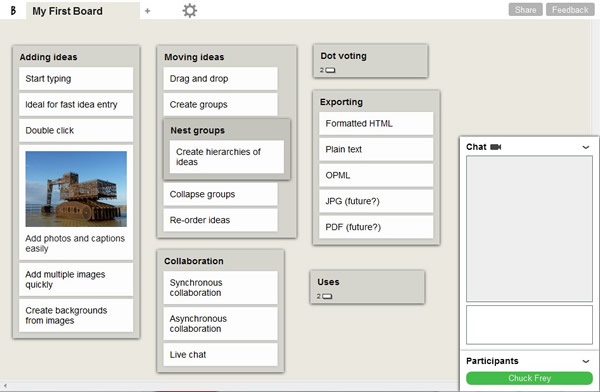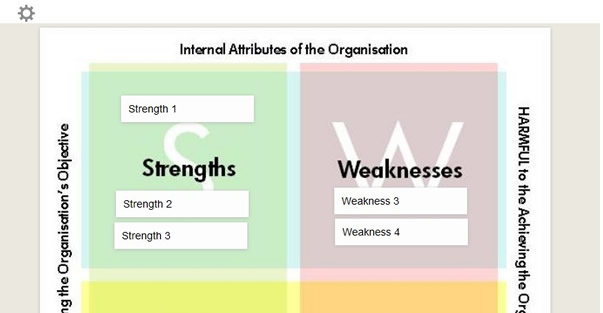Boardthing is a powerful, flexible new, web-based visual thinking and brainstorming tool that is perfectly designed to empower small teams to generate, organize and prioritize their ideas.
Boardthing, which is currently in private beta, is the brainchild of Dave Gray, a well-known design and visual thinking expert. He is the founder of the design consultancy XPLANE, which was acquired by the Dachis Group in 2010. He has authored two books on design, change and innovation: Gamestorming: A Playbook for Innovators, Rulebreakers, and Changemakers and The Connected Company.
Gray partnered with two developers to create a prototype of Boardthing after it became obvious to them that no tool existed that could easily replicate the experience of small-group brainstorming with Post-it notes and dot voting. Their approach is, not surprisingly, based upon the tenets of design thinking: Launch a crude prototype of a product idea, seek customer feedback and iterate quickly. Based upon the feedback Gray and his partners have received, Boardthing is quickly evolving into an elegant, easy-to-use collaboration visual thinking tool that feels just right for many types of projects.
Adding ideas to your board
Even at this early stage of development, Boardthing is already robust, stable and intuitive. Its minimalist interface makes excellent use of the keyboard to quickly enter ideas, which are captured within “cards” – rectangular white rectangles that resemble index cards. To capture an idea, you can simply start typing; a card will pop up in the middle of the workspace to contain it. To save it, tap the Enter key and then start typing your next idea. This method of input enables you to capture a large number of ideas in a very short time, without interrupting your creative flow. You can also double-click to create a new card at a specific location within the workspace.
In addition to text, you can add images to your boards and give them captions. In the insert image dialog box, you can even multi-select images, adding them all at once to your board. That’s convenient! You can resize any image as needed, even expanding it to the size of the workspace. When you “lock” a resized image, it moves to the background, so the idea cards will appear on top of it. That means you can create images with 4-square grids, SWOT diagrams, business model canvas and other business types of business diagrams – very cool! (click on the image below to see an expanded version of this SWOT example created in Boardthing)
Organizing your ideas
 Moving ideas is done by dragging and dropping them. If you drag one idea over another, the destination idea becomes a container for it. Once you have populated your group with a number of ideas, you can easily re-order them by dragging and dropping them. You can even nest groups within a hierarchy. To save space, you can collapse groups by double-clicking on the group header. This enables you to easily manage a large number of ideas within a single board.
Moving ideas is done by dragging and dropping them. If you drag one idea over another, the destination idea becomes a container for it. Once you have populated your group with a number of ideas, you can easily re-order them by dragging and dropping them. You can even nest groups within a hierarchy. To save space, you can collapse groups by double-clicking on the group header. This enables you to easily manage a large number of ideas within a single board.
Collaboration capabilities of Boardthing
A chat window on the right side of the workspace makes it easy to collaborate and brainstorm with others. Ideas are added as soon as participants type them. As part of the developers’ commitment to simplicity, Boardthing currently doesn’t track who submitted which ideas, enable a participant to act as the moderator, rollback the workspace to a specific date and time or other advanced small group collaboration features. It’s very egalitarian. But that’s OK – anyone can start using Boardthing immediately, with no learning curve. That’s the beauty of it.
Voting on ideas
 When you’re done submitting ideas and organizing them into groups, you can vote on them. Simply click on the group’s header, and a “dot voting” option pops up. A radio button appears next to each idea in the group. Clicking on a button increments the counter for that idea by a value of 1.
When you’re done submitting ideas and organizing them into groups, you can vote on them. Simply click on the group’s header, and a “dot voting” option pops up. A radio button appears next to each idea in the group. Clicking on a button increments the counter for that idea by a value of 1.
In a physical brainstorming session, each participant gets a certain number of dots they can distribute at will, even placing several dots on their favorite ideas. Boardthing doesn’t restrict the total number of dots per user, or the number of times you can vote for each idea. For now, you and your collaborators are limited to the honor system.
Exporting your boards
At this early stage of development, you can export your boards to formatted HTML, text and OPML. I tried the formatted HTML export; it created a hierarchical outline of the text, with an image embedded in it. When I asked Gray what other export formats will be supported in future versions of Boardthing, he said probably JPG and PDF.
What can you use Boardthing for?
Boardthing has been designed with brainstorming and small group collaboration in mind. It’s equally adept at handling synchronous sessions, where all participants are logged in and participating at the same time, or asynchronous sessions, where participants log in at different times to do so. This makes it ideal for applications where you need a group of customers to vote on a set of potential product features. But to be truly useful and fair for this type of application, the developers will need to make it possible to assign specific numbers of “dot votes” to each customer. Otherwise, people could skew the results to the point where they don’t accurately reflect the aggregate of all customers’ opinions.
How can you get a Boardthing account?
If you would like to try out Boardthing, you can sign up on the application’s website. The developers are actively seeking feedback and suggestions to improve it. Even at this early stage of development, they have created a knowledge base and FAQ page that includes a series of screen capture videos that do a terrific job of explaining how to use Boardthing. You can view them here:
http://boardthing.uservoice.com/knowledgebase
If you have any interest in small team brainstorming or collaboration, I highly recommend that you take a look at Boardthing. I can’t wait to see where the developers take it from here!



Leave a Reply